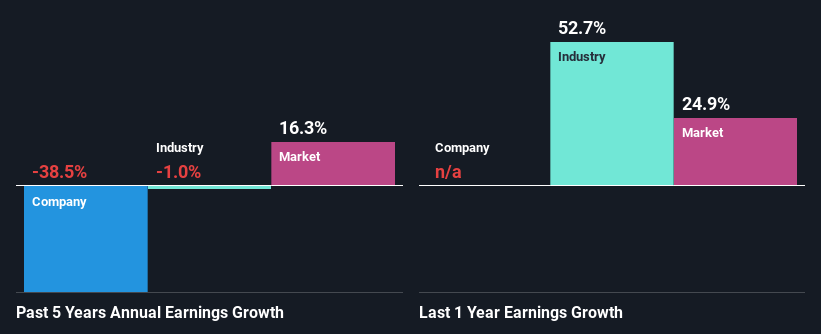SIR Royalty Income Fund's (TSE:SRV.UN) Stock Is Going Strong: Have Financials A Role To Play?
SIR Royalty Income Fund's (TSE:SRV.UN) stock is up by a considerable 7.2% over the past week. Given that stock prices are usually aligned with a company's financial performance in the long-term, we decided to study its financial indicators more closely to see if they had a hand to play in the recent price move. Specifically, we decided to study SIR Royalty Income Fund's ROE in this article.
Return on equity or ROE is a key measure used to assess how efficiently a company's management is utilizing the company's capital. Simply put, it is used to assess the profitability of a company in relation to its equity capital.
View our latest analysis for SIR Royalty Income Fund
How To Calculate Return On Equity?
Return on equity can be calculated by using the formula:
Return on Equity = Net Profit (from continuing operations) ÷ Shareholders' Equity
So, based on the above formula, the ROE for SIR Royalty Income Fund is:
16% = CA$6.8m ÷ CA$41m (Based on the trailing twelve months to March 2022).
The 'return' is the income the business earned over the last year. So, this means that for every CA$1 of its shareholder's investments, the company generates a profit of CA$0.16.
Why Is ROE Important For Earnings Growth?
We have already established that ROE serves as an efficient profit-generating gauge for a company's future earnings. Depending on how much of these profits the company reinvests or "retains", and how effectively it does so, we are then able to assess a company’s earnings growth potential. Assuming everything else remains unchanged, the higher the ROE and profit retention, the higher the growth rate of a company compared to companies that don't necessarily bear these characteristics.
A Side By Side comparison of SIR Royalty Income Fund's Earnings Growth And 16% ROE
At first glance, SIR Royalty Income Fund seems to have a decent ROE. On comparing with the average industry ROE of 14% the company's ROE looks pretty remarkable. As you might expect, the 39% net income decline reported by SIR Royalty Income Fund is a bit of a surprise. Based on this, we feel that there might be other reasons which haven't been discussed so far in this article that could be hampering the company's growth. For example, it could be that the company has a high payout ratio or the business has allocated capital poorly, for instance.
Next, when we compared with the industry, which has shrunk its earnings at a rate of 1.0% in the same period, we still found SIR Royalty Income Fund's performance to be quite bleak, because the company has been shrinking its earnings faster than the industry.
Earnings growth is an important metric to consider when valuing a stock. What investors need to determine next is if the expected earnings growth, or the lack of it, is already built into the share price. By doing so, they will have an idea if the stock is headed into clear blue waters or if swampy waters await. Is SRV.UN fairly valued? This infographic on the company's intrinsic value has everything you need to know.
Is SIR Royalty Income Fund Making Efficient Use Of Its Profits?
With a high three-year median payout ratio of 60% (implying that 40% of the profits are retained), most of SIR Royalty Income Fund's profits are being paid to shareholders, which explains the company's shrinking earnings. The business is only left with a small pool of capital to reinvest - A vicious cycle that doesn't benefit the company in the long-run. Our risks dashboard should have the 3 risks we have identified for SIR Royalty Income Fund.
Additionally, SIR Royalty Income Fund has paid dividends over a period of at least ten years, which means that the company's management is determined to pay dividends even if it means little to no earnings growth.
Summary
Overall, we feel that SIR Royalty Income Fund certainly does have some positive factors to consider. However, while the company does have a high ROE, its earnings growth number is quite disappointing. This can be blamed on the fact that it reinvests only a small portion of its profits and pays out the rest as dividends. Up till now, we've only made a short study of the company's growth data. So it may be worth checking this free detailed graph of SIR Royalty Income Fund's past earnings, as well as revenue and cash flows to get a deeper insight into the company's performance.
Have feedback on this article? Concerned about the content? Get in touch with us directly. Alternatively, email editorial-team (at) simplywallst.com.
This article by Simply Wall St is general in nature. We provide commentary based on historical data and analyst forecasts only using an unbiased methodology and our articles are not intended to be financial advice. It does not constitute a recommendation to buy or sell any stock, and does not take account of your objectives, or your financial situation. We aim to bring you long-term focused analysis driven by fundamental data. Note that our analysis may not factor in the latest price-sensitive company announcements or qualitative material. Simply Wall St has no position in any stocks mentioned.

 Yahoo Finance
Yahoo Finance 
